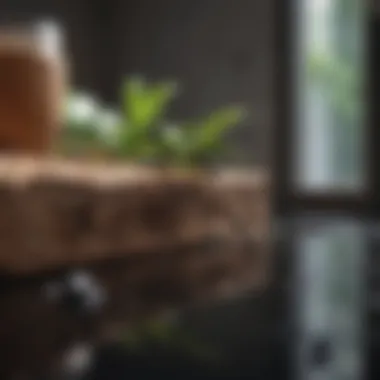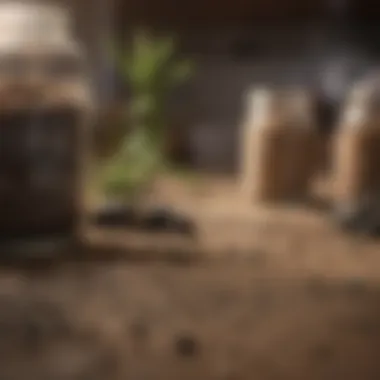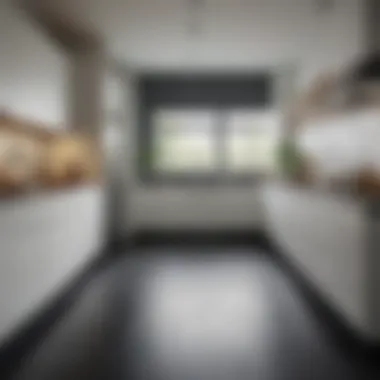Home Remedies to Control Black Ants in Your Kitchen


Intro
Black ants may seem like a minor nuisance, but their presence in the kitchen can quickly escalate into a troublesome infestation. They often invade in search of food and moisture, making kitchens prime targets. Addressing black ant infestations using effective home remedies not only helps in eradicating the pests but also avoids the use of harmful chemicals. This guide explores practical, natural solutions any homeowner can employ to manage and prevent these unwelcome guests.
Through this article, we will discuss the science behind various remedies, including food sources that attract ants, methods to deter their intrusion, and strategies to maintain a pest-free kitchen environment. By equipping yourself with knowledge about home remedies for black ants, you regain control over your living space, ensuring a cleaner and healthier environment for you and your family.
Understanding Black Ants
Understanding black ants is crucial for effectively managing infestations in kitchens. The knowledge of these insects aids homeowners in devising appropriate strategies to deter them. Black ants, particularly the common species such as the Carpenter ants and the Pavement ants, possess unique characteristics that differentiate them from other pests. Recognizing their behavior and habitats can guide effective treatment and preventive measures. This section elaborates on the species, their behavior, and why they are drawn to kitchens, enabling a more informed approach to pest control.
Species Overview
There are several species of black ants, with the Carpenter ant and Pavement ant being the most prevalent in urban areas. Carpenter ants are known for nesting in wood, and they can cause structural damage to homes. In contrast, Pavement ants often create their nests in the cracks of sidewalks or under stones. Both types are generally harmless but can quickly become a nuisance when they invade kitchens. By understanding the species present, homeowners can diagnose their problem correctly and choose the best remedy.
Behavior and Habits
Black ants are social insects, living in colonies that can range from a few dozen to thousands. Their foraging behavior is methodical, often leading them in long trails to food sources. This is why seeing one ant usually indicates many more in the vicinity. They are primarily attracted to sugary and protein-rich foods, making kitchens a prime target. Knowledge about their foraging patterns can help in setting effective traps or deterrents, focusing efforts on their hotspots or common paths.
Attraction to Kitchens
Kitchens provide a hospitable environment for black ants for several reasons. First, they offer easy access to food sources, particularly crumbs and spills that may go unnoticed. Second, kitchens often contain moisture from sinks or appliances, which is essential for the survival of ants. Being aware of these attractive features can aid homeowners in modifying their kitchen environment to make it less appealing to these intruders. Simple practices, such as cleaning up spills promptly and sealing food, can significantly reduce the likelihood of infestation.
Identifying the Problem
Understanding how to effectively address black ant infestations in the kitchen begins with Identifying the Problem. Without a clear recognition of signs of infestation or knowledge of where the ants are coming from, any treatment efforts may be misdirected. Black ants can quickly reproduce and establish colonies, making early detection crucial. This section uncovers the indicators homeowners should watch for and how to locate the source of the infestation. By being vigilant, one can prevent a minor problem from escalating into a major nuisance.
Signs of Infestation
A key step in managing black ant infestations involves recognizing telltale signs. First, look for trails. Ants often create visible paths to food sources. These can appear as lines of ants traveling in a consistent direction.
Second, check for food access points, particularly in kitchens where loose food crumbs or spills may be present. Other signs include ant nests, which could be located nearby. If you notice increased activity, search for small piles of dirt or debris, which may indicate a nest.
Additional indicators can be the presence of dead ants, particularly near entry points or nests. Close observation can help identify the scale of the issue.
- Possible indicators of black ant infestations:
- Visible trails of ants
- Food particles or spills
- Nests or debris
- Dead ants around the premises
Determining the Source
Once the signs of black ant infestation are detected, it is essential to determine the source. This analysis usually involves tracing the ant trails back to their origin. Start by following the path of the ants. They can often lead you to areas where food is stored or left out.
Furthermore, examine for any cracks or crevices, as ants can enter through very small openings. Kitchens are particularly susceptible due to their abundance of food sources.
Sometimes, thsy can come from outside, so checking windows and doors for gaps is crucial.
- Steps to determine the source:
- Follow the ant trails.
- Inspect food storage areas.
- Check for entry points such as cracks in walls, windows, or doors.
- Look around plumbing and electrical work for potential access.
Leveraging this organized approach will increase the chances of successfully managing the black ant problem in the kitchen.
Natural Remedies for Black Ants
Natural remedies for managing black ants in the kitchen provide homeowners with effective and environmentally friendly alternatives to chemical pesticides. These solutions often emphasize minimal toxicity while still addressing the infestation issue directly. Understanding various natural remedies lets you choose the best options based on available ingredients and specific circumstances. Additionally, many remedies are simple to apply, require little specialized knowledge, and are often cost-effective.
Vinegar Solutions
How to Apply Vinegar
To apply vinegar against black ants, mix equal parts of water and vinegar in a spray bottle. Shake the mixture well and then spray it liberally along ant trails, entry points, and any areas where ants are seen. This acidic solution disrupts the scent trails that ants use to navigate. This aspect is crucial because breaking these trails can help prevent further ant movements into your kitchen.
The key characteristic of vinegar solutions is their accessibility. Most households already have vinegar on hand, making it a convenient choice. However, while vinegar is a strong deterrent, it may not completely eliminate the ant colony. If the source is not addressed, ants may return.


Effectiveness of Vinegar
Vinegar's effectiveness lies in its ability to mask pheromone trails used by ants. When ants can’t follow their trails, they tend to scatter, which offers temporary relief from the infestation. This unique feature of vinegar makes it appealing for many homeowners looking for immediate results without harmful chemicals. However, for a significant problem, repeated applications may be necessary, and vinegar will not kill ants; it simply repels them.
Boric Acid Mixtures
Creating the Mixture
To create a boric acid mixture, combine one part boric acid with three parts sugar and one part water in a container. Stir well until the boric acid dissolves. This mixture appeals to ants because of the sugar, while the boric acid serves as an effective poison. This method is useful because it targets ants' feeding behaviors directly. The balance of sugar and acid caters to the ants’ natural desires while strategizing to eliminate them.
The benefit of creating a boric acid mixture is its ability to both attract and poison the ants. However, care must be taken when handling boric acid, especially around pets or children.
Targeting Ant Trails
Applying the boric acid mixture to known ant trails increases effectiveness. Place small dabs or bait in shallow containers along these routes. This strategic placement allows ants to take the bait back to the colony, promoting a more widespread elimination strategy.
The unique aspect of targeting ant trails is that it addresses the root of the problem, potentially leading to long-term management of the infestation. Yet, the time taken to see results can vary, which may frustrate homeowners seeking instant solutions.
Essential Oils Usage
Recommended Oils
Some essential oils, such as peppermint oil and tea tree oil, are known for their ant-repelling properties. To use these oils, blend a few drops with water in a spray bottle. Not only does this method provide a pleasant scent, but it also provides a natural deterrent against black ants.
The key characteristic of recommended oils is their dual function as a repellent and air freshener. However, be mindful that essential oils need frequent reapplication, especially after cleaning or mopping.
Application Techniques
To effectively apply essential oils, spray the solution around kitchen areas where ants have been found. Focusing on entry points and trails is essential for deterring them. Given the volatility of these oils, they may evaporate quickly, potentially decreasing effectiveness over time.
This strategy is appealing due to its non-toxic nature, making it safe for households with pets and children. The downside is that essential oils are usually a temporary solution, requiring consistency in application.
Homemade Bait Traps
Ingredients Needed
The main ingredients for a homemade bait trap often include sugar, water, and boric acid. These components work together to create an attractive and harmful bait for ants. Mixing these elements allows the bait to attract ants effectively, drawing them in to consume the mixture.
The primary advantage of these traps is that they can be made from household items, reducing additional costs. However, monitoring the traps is necessary to maintain efficiency and effectiveness.
Step-by-Step Instructions
To create a bait trap, first mix the sugar, water, and boric acid in a small bowl. Pour the mixture into shallow containers. These should be placed along ant trails or areas of heavy activity. Regularly check these traps and refill them as needed.
This step-by-step process is straightforward, making it a popular choice for homeowners. The downside, however, is that maintaining and checking the traps can be tedious over time.
Diatomaceous Earth
Application Method
Diatomaceous earth can be applied by lightly dusting it around entries and trails. This powdery substance damages the exoskeletons of ants as they walk over it, eventually leading to dehydration and death. The key characteristic of this method is its ability to kill ants mechanically, rather than chemically, making it appealing for those concerned about toxins.
Its effectiveness is long-lasting, as diatomaceous earth does not lose its properties easily. However, care must be taken to keep it dry; moisture can render it ineffective.
Safety Considerations
While diatomaceous earth is generally safe for humans and pets, it is crucial to use food-grade quality to avoid respiratory issues. This focus on safety makes it a valuable addition to your pest control toolkit. However, be aware that inhalation of any powder—especially in large amounts—can be harmful, so use it carefully and apply in ventilated areas.


By exploring different natural remedies, homeowners can effectively manage black ant infestations while reducing reliance on chemical solutions. Each method presents distinct advantages and requires consideration of specific household factors.
Using Household Items
Using household items offers various advantages in the quest to manage black ant infestations in the kitchen. Utilizing common items readily available at home can be both economical and effective. This approach minimizes the need for expensive or chemical-based solutions, making it suitable for many homeowners.
Common household staples often have properties that deter pests effectively, without the side effects associated with more industrial treatments. Furthermore, relying on ingredients found in kitchens reduces the risk of exposure to harmful substances, contributing to a safer environment for families and pets.
Soap and Water Solutions
Mixing Ratios
The mixing ratios of soap and water play a crucial role in creating an effective solution to combat black ants. The general guideline is to mix two tablespoons of liquid dish soap with approximately one quart of water. This concentration is potent enough to disrupt the ant's natural functions yet gentle enough not to damage surfaces or fabrics typically found in kitchens.
This particular ratio is popular among homeowners due to its simplicity. It combines two easily accessible items and does not involve any complex preparation. The unique feature of this mix lies in its fat molecules within the soap, which effectively suffocate ants upon contact. While this method is effective, it is important to note that achieving the right balance in the mix can determine success. Too much soap may leave residues, while too little might not have the expected impact.
Application Process
The application process for soap and water solutions is straightforward, which also adds to its popularity. Homeowners can simply transfer the mixed solution into a spray bottle. It can then be applied directly to the areas where ant activity is observed. Spraying near entry points or ant trails is crucial, as it targets ants when they are actively moving.
A key characteristic of this method is its immediate effectiveness. Upon contact, it rapidly neutralizes ants. However, it may require frequent reapplication, especially after cleaning or if it rains. This aspect is something to consider, as ongoing maintenance might be necessary to achieve long-term results.
Cinnamon as Deterrent
Cinnamon functions as a natural repellent for black ants, based on its strong scent, which disrupts the ants' pheromone trails. When cinnamon is sprinkled around entry points or ant activity areas, it creates a natural barrier that ants are less likely to cross. This method is both easy to implement and safe for household use. However, its effectiveness may vary, and like soap solutions, it may need frequent reapplication to maintain its deterrent effect.
Coffee Grounds
Coffee grounds can be used effectively against black ants. Sprinkling spent coffee grounds near ant trails can deter ants due to the strong smell, which disrupts their sense of smell. Using coffee grounds is environmentally friendly, as it provides a reuse method for waste material. It is important to note that this method may also attract other pests, so placement must be strategic. Regular applications may be necessary for continual effect and to address new ant incursions.
With these simple household items, it is possible to manage black ant infestations in a cost-effective and safe manner. The focus should always remain on maintaining clean surfaces and preventing future invasions, in alignment with the principles of integrated pest management.
Preventive Measures
Preventive measures are vital in addressing black ant infestations, especially in kitchens. These pests are drawn to food sources and moisture, making kitchens an ideal habitat. By taking proactive steps, homeowners can reduce the likelihood of ants becoming a problem. Achieving cleanliness, sealing potential entry points, and conducting regular inspections can make a considerable difference. These actions not only prevent infestations but also promote a healthier living environment.
Kitchen Hygiene Practices
Maintaining excellent kitchen hygiene is essential for ant prevention. Food spills and crumbs attract these insects, so practices that minimize these issues are key. To ensure cleanliness, follow these tips:
- Clean surfaces daily: Wipe down counters, tables, and stovetops with soap and water or a mild disinfectant.
- Store food securely: Keep food in airtight containers. This limits access to ants and other pests.
- Manage waste: Empty trash regularly and use bins with tight-fitting lids. This reduces the chance of attracting ants looking for food.
- Avoid leaving dirty dishes: Wash dishes right away or place them in a dishwasher promptly.
By keeping a clean kitchen, the environment becomes less hospitable to ants.
Sealing Entry Points
Sealing entry points is a preventive measure that can significantly diminish ant invasions. Ants can exploit tiny cracks and openings, so it is crucial to inspect your home for possible access points. Consider the following steps:
- Inspect windows and doors: Make sure screens fit well and are free of tears. Weather stripping can help seal gaps around doors.
- Check for cracks and holes: Look at walls, foundations, and around plumbing. Seal any noticeable gaps with caulk or similar materials.
- Examine vents: Ensure that vents are fitted with screens to prevent ants from entering through them.
By addressing these entry points, homeowners can create an additional barrier against potential infestations.
Regular Inspections
Conducting regular inspections of your kitchen and home is another effective preventive strategy. This practice helps identify any issues before they escalate into larger problems. The following suggestions can guide the inspection process:


- Inventory food sources: Regularly check pantry items for pests and expired products. Discard anything that is damaged or opened.
- Inspect high-risk areas: Look behind appliances like refrigerators or ovens, as these areas often accumulate food residue.
- Document any signs of ants: Take notes if you see any ant trails or nests. Early detection can help curtail populations before they grow.
By implementing these preventive measures, homeowners position themselves to effectively control and prevent black ant infestations in their kitchens. By making changes to daily habits, sealing entry points, and conducting routine inspections, a pest-free environment becomes more achievable.
Evaluating the Effectiveness of Remedies
Evaluating the effectiveness of remedies for managing black ant infestations is a critical step in ensuring a pest-free kitchen. This process allows homeowners to determine which techniques yield the best results and which may not be as beneficial. An accurate evaluation not only saves time and resources but also aids in refining strategies to cope with these nuisances. It’s essential to approach this evaluation with a systematic mindset.
The first consideration when evaluating remedies is to monitor ant activity before and after implementing a solution. This establishes a sense of baseline ant presence and highlights the impacts of the chosen method. Furthermore, long-term assessments are invaluable. They provide insight into whether a single solution can consistently deter black ants or if multiple methods should be employed over time.
"A consistent approach in evaluating remedies is vital for effective pest control."
This evaluation process can also include examining potential side effects or hazards related to certain home remedies. Homeowners must prioritize safety not only for themselves but also for pets and children in the household. As a rule, remedies should be non-toxic and environmentally friendly, aligning with current health guidelines.
In summary, tracking effectiveness plays a significant role in maintaining a healthy kitchen environment. By understanding the performance of chosen remedies, homeowners can adjust their pest management strategies to ensure they are as effective as possible.
Monitoring Ant Activity
Monitoring ant activity provides key insights into the efficacy of the applied remedies. It involves observing the volume and behavior of ants before and after using a chosen method. Some actionable steps include:
- Regular Observations: Check for ant trails, nests, or any signs of resurgence.
- Visual Documentation: Take photos or notes to compare changes over time.
- Frequency: Maintain monitoring at consistent intervals to gather reliable data.
Many effective home remedies may take time to show results, so patience is important. During this period, it’s wise to assess the behavior shift of ants. Are their paths altered, or has their presence diminished? This information will guide further adjustments to pest control measures.
Adjusting Strategies
Adjusting strategies based on observed ant activity is crucial. If you find that a particular remedy does not yield the desired results, consider these considerations:
- Experiment with Combinations: Some methods may work better in tandem. For instance, combining vinegar solutions with boric acid mixtures may enhance effectiveness.
- Modify Application Techniques: Ensure remedies are being applied correctly. Slight variations in method can significantly affect results.
- Seek Alternative Remedies: If one solution fails, research other natural alternatives. Diverse options ensure that your strategies remain flexible and adaptable.
When to Seek Professional Help
Dealing with black ant infestations can be frustrating, especially when home remedies do not yield the desired results. Understanding when to seek professional help is essential for effectively managing the problem. While many homeowners start with natural solutions, certain situations may necessitate turning to pest control experts. This section outlines key factors that influence the decision to enlist professional assistance.
Indicators of Severe Infestation
Identifying a severe infestation is crucial. Here are signs you should consider:
- Large Ant Colonies: If you observe consistently high numbers of black ants in different areas of your kitchen, this may indicate a significant colony nearby.
- Damage to Property: Ants can cause damage to food storage areas and sometimes even structures if they nest within walls or cupboards. If you notice structural weaknesses, it is time to act.
- Persistent Presence: Have you tried various home remedies without any success? An ongoing ant presence despite your best efforts means professional intervention might be necessary.
- Nest Locations: If you locate nests within or near your home, it is best to consult with a professional. They can address the source more effectively.
Realizing these indicators not only saves time but also protects your home from further damage.
Choosing an Exterminator
Selecting the right exterminator requires careful consideration. Here are some recommendations:
- Research Credentials: Always check for appropriate licenses and certifications in pest control. Qualified professionals should hold relevant accreditations.
- Read Reviews: Look at client testimonials on platforms like Facebook or Reddit. These provide insight into the exterminator's reputation and effectiveness.
- Assess Techniques Used: Inquire about their methods. A reliable exterminator should favor integrated pest management (IPM) techniques, which focus on sustainable practices and the reduction of pesticide use.
- Get Estimates: Obtain quotes from several companies to compare prices. This will ensure you receive fair and competitive rates for services.
By understanding these strategic points, homeowners can make informed decisions when dealing with black ant infestations. Prompt action, when warranted, can save both time and resources.
The End
In concluding this exploration of home remedies for managing black ant infestations in the kitchen, it is important to understand the significance of maintaining a pest-free environment. Black ants, while not typically harmful, can be a nuisance and may indicate deeper issues, such as poor sanitation or structural vulnerabilities in your home.
By employing the remedies discussed in this article, homeowners gain practical, accessible solutions that are non-toxic and easy to implement. These strategies not only aid in immediate management of ant populations but also emphasize preventive measures that contribute to long-term effectiveness. Regular cleaning and sealing entry points will drastically reduce the chances of future infestations.
Several key elements must be kept in mind:
- Evaluation of Remedies: Monitoring the effectiveness of remedies is crucial. If one method does not yield results, adjusting the approach may be necessary.
- Safety Considerations: When using home remedies, especially those involving substances like boric acid, it is vital to ensure the safety of children and pets. Always read instructions thoroughly and apply these remedies with caution.
- Knowledge is Power: Understanding the behavior of black ants helps in tailoring strategies that can mitigate their presence. Knowing their habits can inform where and how to apply various treatments effectively.
"An ounce of prevention is worth a pound of cure." In the context of kitchen ants, this aphorism rings particularly true. Proactive steps to maintain cleanliness and address potential entry points can save homeowners considerable hassle in the future.
In summary, fostering a proactive mindset and integrating these remedies into daily routines support not just the immediate goal of ant control but also contribute significantly to a healthier living environment. By taking these steps, homeowners cultivate a kitchen space that is less vulnerable to pests and more enjoyable to use.







